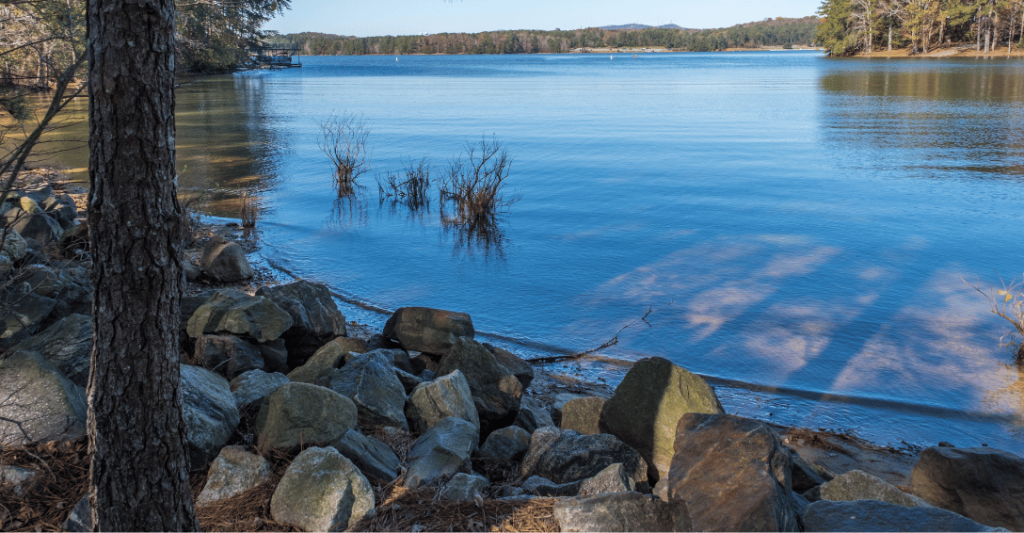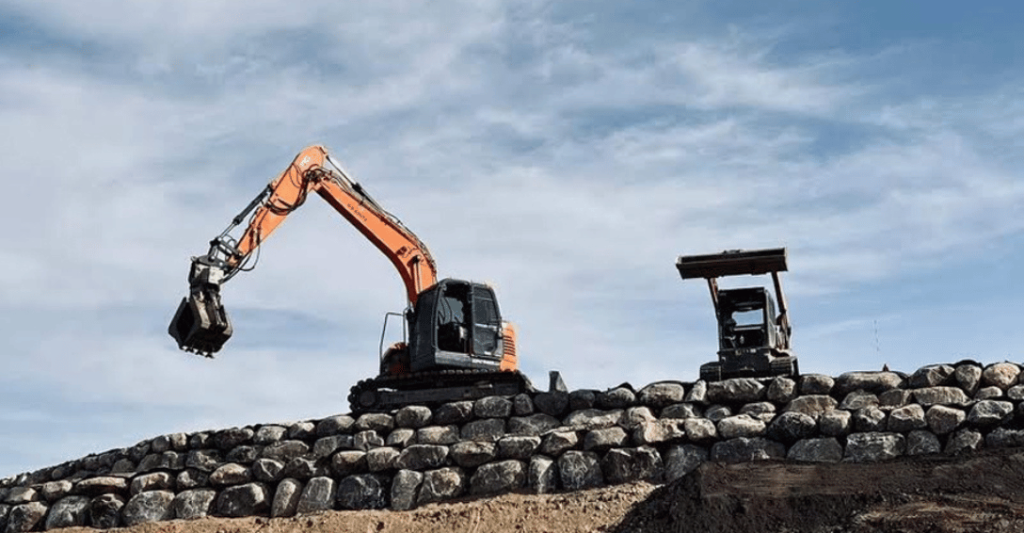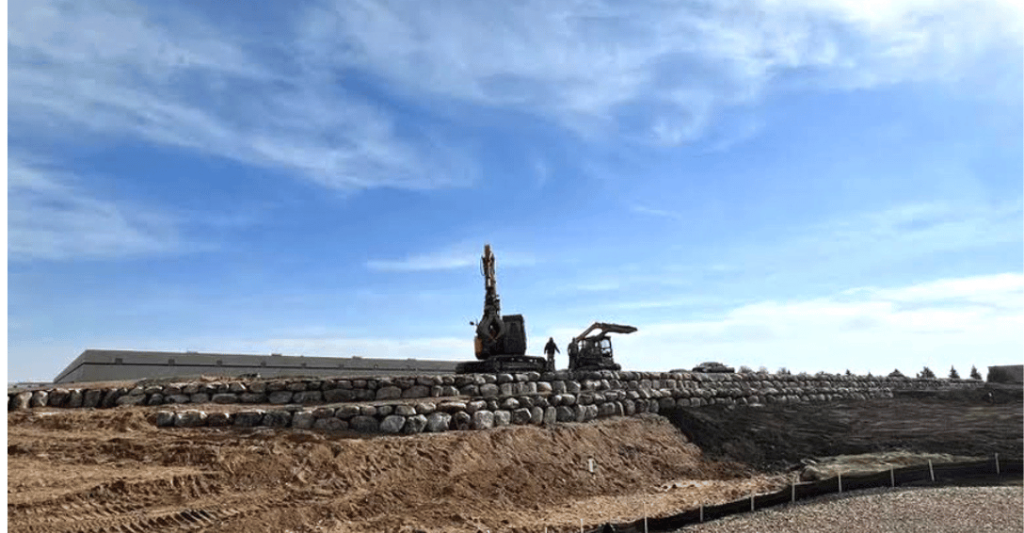Shoreline Riprap
Rugged, reliable and resilient, riprap shorelines are the ultimate solution for preventing erosion and ice damage on the shores of lakes, rivers and ponds. These structures have gained popularity in recent years due to their durability and longevity, making them a popular choice for property owners looking to protect their shoreline investments.
SHORELINE RIPRAP
The benefits of riprap shorelines are numerous; they provide excellent protection against waves, currents and ice flows while also offering an attractive aesthetic appeal that blends well with natural surroundings.
What riprap shorelines are, the benefits they offer, how they are designed and constructed, their potential environmental effects as well as maintenance requirements. By exploring these aspects of riprap shorelines in greater depth we aim to provide readers with a comprehensive understanding of this important protective structure that has become increasingly relevant in today's changing climate conditions.
What is Riprap?
The construction of durable and aesthetically pleasing barriers along the water's edge to prevent erosion and ice damage is a specialized service offered by this company. These barriers are known as riprap shorelines, which involve the use of large rocks or boulders placed along the shoreline in a specific pattern to absorb wave energy and protect against erosion. There are different types of riprap shorelines available, including traditional rock-filled structures, gabions (wire baskets filled with rocks), concrete blocks, and other materials. The cost of installing riprap shorelines varies depending on several factors such as the size of the project, type of material used, accessibility to the site, and labor costs. However, it is important to note that while initial installation costs may be higher compared to other methods like vegetation planting or wooden walls, riprap shorelines offer long-term benefits such as durability and low maintenance requirements. Installation requires expertise in planning and execution since proper positioning and compaction techniques must be observed for optimum performance. In fact, the use of it instead of natural shorelines can take habitat away from critters such as turtles, shallow-water fish, otters, and other shoreline-reliant animals. Source: lakeleelanau.org


Benefits of Riprap Shorelines
One of the most durable and aesthetically pleasing options for protecting shorelines from erosion and ice damage is riprap. Riprap shorelines offer a solution that combines durability with beauty, making it a popular choice among homeowners, businesses, and municipalities alike. The cost effectiveness of riprap shorelines is one of its many benefits. It provides long term durability while also adding aesthetic appeal to any property. This makes it an attractive option for those who want to protect their shoreline investment without sacrificing its visual appeal. With proper installation and maintenance, riprap can withstand harsh weather conditions and remain intact for decades, making it a smart investment for those looking for a permanent solution to shoreline protection.
Benefits of Riprap
Riprap has several benefits that make it an attractive option for shoreline protection. One of the most significant benefits is its natural-looking appearance. Riprap can blend in with the surrounding environment, making it a more aesthetically pleasing option than other methods.
Riprap is also effective at controlling erosion. The rocks absorb the energy of waves and currents, reducing their impact on the shoreline. This can help prevent soil erosion and protect the property from damage.
Design and Construction of Riprap Shorelines
In the realm of waterfront protection, there exists a meticulous process for designing and constructing a durable and visually appealing solution. The design of riprap shorelines takes into account the specific needs of each project, including rock placement and shoreline stabilization. The construction process involves careful planning to ensure that erosion prevention measures are in place and that the final product meets the highest standards.
Rock placement is a critical aspect of riprap shoreline design. Rocks must be placed in a specific pattern to create a stable barrier against water erosion. In addition, the size and shape of individual rocks must be carefully considered to ensure that they fit together tightly and provide maximum strength.
Shoreline stabilization involves creating a solid foundation for the rocks by excavating soil and compacting it to create an even surface. This process ensures that the riprap will remain in place over time, even under adverse conditions such as high winds or heavy rainstorms.
By following this meticulous process, riprap shorelines can provide long-lasting erosion prevention while enhancing the natural beauty of waterfront properties.
Professional rip rap installation can be a significant investment, but, you want something to last decades and that protects your shoreline property and home.
Source: wlddi.com
Proper rip rap installation includes: shaping the slope of the area to a specific angle, covering the slope with the right textile fabric, securing the fabric from movement, covering that with rock of a particular size to the right depth.
Rip rap is a popular form of shoreline restoration used to protect the integrity of shorelines. When properly installed, rip rap can help prevent erosion and reduce damage from flooding and wave action. To ensure that rip rap is properly installed, certain steps must be taken to ensure its effectiveness.

Additionally, riprap is durable and long-lasting. It can withstand the elements and requires minimal maintenance, making it a cost-effective option in the long run.
Environmental Effects of Riprap Shorelines
The environmental impact of using hard structures, such as riprap shorelines, to protect waterfront properties warrants further investigation. While these structures are effective in preventing erosion and ice damage, they may unintentionally contribute to shoreline degradation in other areas and have negative consequences on the natural ecosystem. For instance, riprap shorelines can alter the flow of water and sediments along the shoreline, which affects aquatic habitats and may lead to increased erosion elsewhere. Additionally, hard structures can impede beach access for wildlife and interfere with natural processes like wave action that help maintain healthy ecosystems.
Potential solutions to mitigate the ecological impact of riprap shorelines include exploring alternative options such as living shorelines or soft engineering techniques that incorporate vegetation or natural materials instead of hard structures. It is also important to carefully consider the placement and design of riprap shorelines to minimize their impact on surrounding habitats. To ensure long-term sustainability, regular monitoring should be conducted to evaluate any changes in the ecosystem due to the presence of hard structures. Ultimately, balancing human needs with environmental conservation is crucial when designing coastal protection measures like riprap shorelines.
Own A Lakefront Property?
According to the Watershed Council, losing just one foot of shore on a lakefront property can amount to more than $9,000 in decreased property value.
Unlike other erosion control methods, rip rap retaining walls absorb wave energy as opposed to diverting it to cause damage elsewhere.
Our watershed and shoreline have everything from natural woodlands, aquatic vegetation, and beaches to man-made control structures (i.e., riprap) to combat soil erosion.
Source: lakeleelanau.org
With over a decade of lakefront restoration experience, we'll assess your property and correct any existing shoreline issues as well as customize a plan to address future problems so you can enjoy your home away from home worry-free for years to come.
Maintenance of Riprap Shorelines
This section focuses on the maintenance of hard structures used to protect waterfront properties, exploring ways to ensure their long-term sustainability while minimizing negative ecological impact. Riprap shorelines are a popular choice for preventing erosion and ice damage, but they require regular maintenance to remain effective.
Repair methods vary depending on the severity of the damage and may include adding new rocks or repairing existing ones. It is important to address any damage as soon as possible to avoid further erosion and potential safety hazards.
Cost analysis is also an important factor in riprap shoreline maintenance. While it may seem costly upfront, regular upkeep can save money in the long run by preventing more extensive repairs or even complete replacement.
Best practices for maintaining riprap shorelines include regularly inspecting for damage, removing debris that can trap water and cause erosion, and avoiding heavy equipment on the shoreline whenever possible. By following these practices and addressing any issues promptly, riprap shorelines can continue to provide durable protection while minimizing negative environmental impacts.
Shoreline Erosion?
If your shoreline is suffering from erosion, riprap can provide a lasting solution. Riprap, sometimes referred to as a riprap wall, seawall, revetment, or hard stabilization, is a barrier of stones installed on an aquatic filter fabric. This prevents further erosion while adding beauty to your waterfront property. It can also increase the value of your home or cabin!
Riprap should always be installed by experienced and knowledgeable shoreline experts like us – otherwise you risk doing more harm than good. We know exactly how to lay the stones in accordance with geological and environmental considerations. That means no disruption to the natural environment and no risks posed by muskrats or other rodents! Plus, because we use fieldstone when possible, you get beautifully natural looking results that add confidence in their durability and resilience.
Frequently Asked Questions
When considering shoreline protection options, cost comparison is an important factor to consider. While some materials may have a lower upfront cost, it's crucial to also consider material durability and maintenance requirements over time. One example that illustrates this point is the analogy of purchasing a cheap umbrella versus a high-quality one. Sure, the cheaper option may save money in the short-term, but it won't last as long or be as effective in protecting you from the elements. Similarly, while riprap shorelines may have a higher upfront cost than some alternatives, they provide unparalleled durability and require minimal maintenance over time, ultimately saving money in the long run compared to constantly repairing or replacing less durable options.
The installation of shoreline protection on steep and rocky coastlines presents significant challenges due to the terrain's unique characteristics. The natural slope of the land can make it difficult to establish a stable base for any structure, including shoreline protection. Additionally, the presence of rocks and other obstacles can impede installation efforts, making it challenging to achieve a consistent and effective solution. However, with careful planning and expert know-how, these challenges can be overcome, allowing for successful installation of shoreline protection on even the most challenging terrain.
When considering the installation of any shoreline protection, there are various timeframe considerations that must be taken into account. Riprap shorelines, in particular, require careful planning and execution to ensure that the project is completed within a reasonable amount of time. The environmental impact of riprap shorelines is also an important factor to consider during installation, as they can disrupt natural habitats and cause water quality issues if not properly managed. Additionally, maintenance requirements should be considered when choosing this type of shoreline protection as regular upkeep may be necessary to ensure its effectiveness over time. By carefully considering these factors before beginning a riprap shoreline installation project, property owners can ensure the success and longevity of their investment.
Before installing any shoreline protection or restoration, it is crucial to determine if there are any permit requirements that need to be met. Depending on the location and environmental impact of the project, permits may need to be obtained from local, state, or federal agencies. Failure to obtain necessary permits can result in fines and legal issues. Additionally, it is important to consider the potential impact on shoreline property values and surrounding ecosystems when undertaking a shoreline project. Proper planning and consideration of all factors can ensure a successful installation that benefits both the property owner and the environment.
When it comes to shoreline protection, property owners may wonder if they can customize their options to fit their aesthetic preferences. Customization options may include choosing the size and color of rocks used in riprap shorelines or incorporating vegetation into the design. However, it is important to consider durability considerations and environmental impact when making these decisions. While customization may enhance the visual appeal of a shoreline, it should not compromise its effectiveness in preventing erosion and ice damage. Ultimately, finding a balance between aesthetics and functionality will ensure that the shoreline remains both beautiful and protected for years to come.
While it is possible for homeowners to install riprap, professional installation is recommended. Proper installation is essential for the effectiveness and longevity of the riprap.
Riprap can provide habitat for marine life, including fish and invertebrates. The rocks can provide shelter and food sources, improving the overall health of the ecosystem.
Riprap is a natural-looking and effective method of shoreline protection that can be more cost-effective than other methods in the long run. Its durability and minimal maintenance requirements make it an attractive option for property owners. If you are interested in learning more about riprap and how it can benefit your shoreline, please contact us for more information.
Riprap shorelines have many benefits that make them the best choice for preventing erosion and ice damage on the shorelines of lakes, rivers, and ponds. Their durability and toughness are unmatched, making them a cost-effective option in the long run. The design and construction process of riprap shorelines require expertise, attention to detail, and knowledge of environmental regulations.
However, it is important to consider the potential environmental effects of these structures. Riprap shorelines can impact aquatic habitats and water quality if not properly designed and built according to DNR-approved guidelines. Regular maintenance is also crucial to ensure their effectiveness over time.
Overall, as the idiom goes 'an ounce of prevention is worth a pound of cure.' Investing in a high-quality riprap shoreline can save property owners from costly repairs down the line while protecting our natural resources for future generations.
Services offer around Lent Minnesota:
• • Google map
